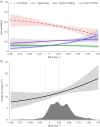Blue whales increase feeding rates at fine-scale ocean features
- PMID: 35975432
- PMCID: PMC9382224
- DOI: 10.1098/rspb.2022.1180
Blue whales increase feeding rates at fine-scale ocean features
Abstract
Marine predators face the challenge of reliably finding prey that is patchily distributed in space and time. Predators make movement decisions at multiple spatial and temporal scales, yet we have a limited understanding of how habitat selection at multiple scales translates into foraging performance. In the ocean, there is mounting evidence that submesoscale (i.e. less than 100 km) processes drive the formation of dense prey patches that should hypothetically provide feeding hot spots and increase predator foraging success. Here, we integrated environmental remote-sensing with high-resolution animal-borne biologging data to evaluate submesoscale surface current features in relation to the habitat selection and foraging performance of blue whales in the California Current System. Our study revealed a consistent functional relationship in which blue whales disproportionately foraged within dynamic aggregative submesoscale features at both the regional and feeding site scales across seasons, regions and years. Moreover, we found that blue whale feeding rates increased in areas with stronger aggregative features, suggesting that these features indicate areas of higher prey density. The use of fine-scale, dynamic features by foraging blue whales underscores the need to take these features into account when designating critical habitat and may help inform strategies to mitigate the impacts of human activities for the species.
Keywords: Lagrangian coherent structures; baleen whale; biologging; finite-time Lyapunov exponent; habitat resource selection; movement ecology.
Conflict of interest statement
We declare we have no competing interests.
Figures





References
-
- Levin SA. 1992. The problem of pattern and scale in ecology. Ecology 73, 1943-1967. (10.2307/1941447) - DOI
-
- Sawyer SC, Brashares JS. 2013. Applying resource selection functions at multiple scales to prioritize habitat use by the endangered Cross River gorilla. Divers. Distrib. 19, 943-954. (10.1111/ddi.12046) - DOI
-
- Johnson DH. 1980. The comparison of usage and availability measurements for evaluating resource preference. Ecology 61, 65-71. (10.2307/1937156) - DOI
-
- Levin SA. 1976. Population dynamic models in heterogeneous environments. Annu. Rev. Ecol. Syst. 7, 287-310. (10.1146/annurev.es.07.110176.001443) - DOI
